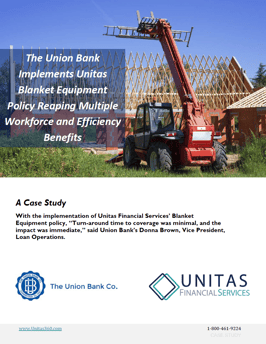 While many lenders are familiar with blanket coverages designed to eliminate the need to track and force-place insurance on mortgage and titled portfolios, fewer may be familiar with an alternative blanket coverage designed to protect the lender’s commercial equipment portfolio in cases of lapsed insurance coverage.
While many lenders are familiar with blanket coverages designed to eliminate the need to track and force-place insurance on mortgage and titled portfolios, fewer may be familiar with an alternative blanket coverage designed to protect the lender’s commercial equipment portfolio in cases of lapsed insurance coverage.
Collateral such as farm equipment, semis, dump trucks, and other business equipment are typically not covered under a Vendor’s Single Interest (VSI) policy, or the limit of liability provided for those collateral types is too low to offset larger loan balances. Furthermore, equipment loans are frequently cross-collateralized with real-estate, titled vehicles, or other commercial equipment. Finally, although the frequency of insurance claims on commercial equipment is somewhat rare when these claims do arise, they can have a significant impact on the financial institution’s bottom line. Blanket Equipment Insurance was designed to fill this gap. Below are a handful of claims examples in which the institution carried Blanket Equipment coverage.
Real Blanket Equipment Claims
|
State |
Amount Paid |
Type of Business |
Incident |
|
NY |
$300,000.00 |
Tire Mold Company |
Break in resulting in all the tire molds & equipment taken. Insurance company suspected it was the owner but could not prove it. |
|
AL |
$250,000.00 |
Lumber Yard |
Fire resulting in loss of lumber yard inventory. |
|
OH |
$676,583.00. |
Plastic Factory |
Building fire caused by outdated electrical, equipment and plastic molds destroyed. |
|
TN |
$35,000.00 |
Home Garage |
Welding sparks causing propane tank to explode, resulting in a garage fire, burnt track hoe, and lowboy trailer. |
|
TN |
$56,610.00 |
Auto Garage |
Theft of tools and welding equipment. Insurance Company suspected it was the owner since the loan was in default but could not prove it. |
What is Blanket Equipment Coverage?
As stated above, a Blanket Equipment policy is designed to cover tangible collateral that a typical VSI program doesn’t offer, including agricultural equipment, semi’s, dump trucks, commercial autos, and general business assets and inventory. All-risk physical damage including collision, rollover, and fire to uninsured collateral, along with theft, are covered scenarios. Like VSI, valid customer insurance is required at closing and impairment is precedent to filing a valid claim. For this reason, a loss is normally identified at repossession. “General” business equipment encompasses a wide array of collateral—items such as office equipment and inventory. The broad nature of the “general” term allows most equipment taken as collateral to be covered under the policy. Excluded from coverage are accounts receivable, livestock and timber. Equipment used in mining, drilling and oil and gas exploration is also excluded but can be added by endorsement for an additional premium.
How Premium is Calculated?
Because of cross-collateralization with real estate on many equipment-secured loans, determining the accurate balance to insure can be a tough task. While VSI premiums can be passed on to borrowers in most states through a line-item charge, the Blanket Equipment premium is normally paid by the lender based on the monthly outstanding balance in the respective portfolio. In certain situations, and when this number is not realistic to obtain due to loan coding, carriers will allow an annual premium payment. Most lenders will recoup the cost of the policy by forecasting future volume and increasing allowable fees such as origination or application charges.
Limits of Liability
These policies also have higher limits of liability than VSI policies, most generally $500,000 or $1,000,000 per credit agreement. Claims have historically been rare in Equipment portfolios, so premiums are very cost effective, especially if a higher deductible is chosen.
A Blanket Equipment policy will eliminate the need to track and force-place insurance on covered loans after origination and lighten your administration staff’s workload. It also reduces negative contacts with customers and protects you from uninsured exposures you aren’t even aware of. With increased scrutiny on force-placed insurance, blanket coverage also satisfies auditor requirements since the tracking component is not necessary. In addition to eliminating tracking and force-placing coverage, blanket equipment policies can be a cost-effective way to mitigate the risk of uninsured losses on these collateral types.
Are you comfortable with current insurance tracking processes within your institution on commonly complex loans that have multiple collateral pledges? If you want to find out more about how Blanket Equipment Insurance can simplify collateral protection for your equipment portfolio,.
If you want to learn more about how Blanket Equipment impacts a financial institution, click the image below to download a copy of our Blanket Equipment Case Study.





